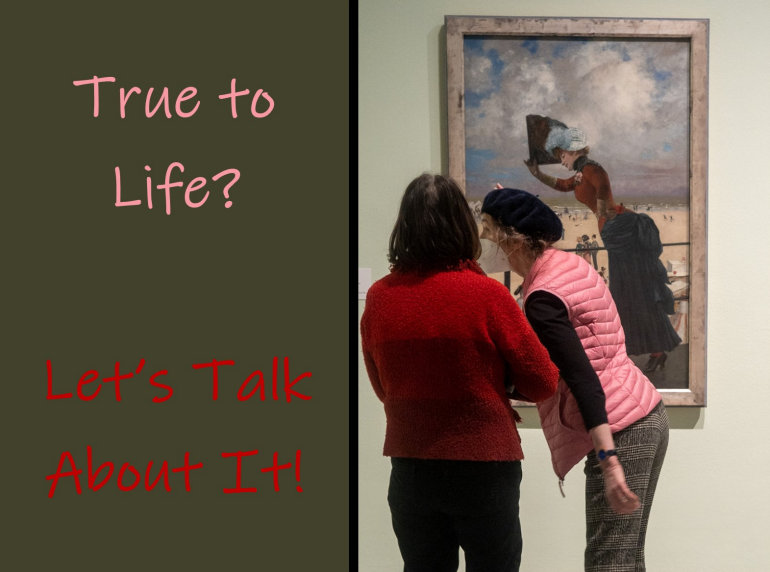ART: Surely no society has been so obsessed with the detailed representation of its everyday life as we find in 17th-century Holland. And no artist so miraculous as Vermeer in transforming the mundane into the timeless. We shall compare iconic Vermeer works with treatments of similar subjects by his contemporaries, and investigate what kind of stories or moral message might lie behind them. rb.



Some questions: Two Dutch paintings involving a woman drinking wine. What are the
similarities and differences between the settings in each picture? Between the lighting in each? What is going
on? What difference does it make that the woman is in profile in one picture, and has her back to us in the other?
Does it make a difference that there are four figures in one, versus only two in the other? Does either picture
imply a story? Does either carry a moral lesson?
POETRY: In the second hour, we shall look at six poems that relate in some way to the
everydayness of everyday life. The poets are Robert Browning, DH Lawrence, Genevieve Taggard, Howard Nemerov, Julia
Kasdorf, and Jane Kenyon. Click here if you want to read them in advance.
PEOPLE: Here are brief bios of the painters and poets discussed in the class.
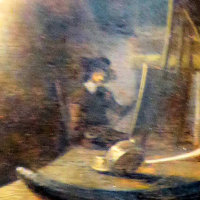 |
Pieter Claesz, 1597–1660. Dutch painter. Though born near Antwerp, he moved to Haarlem in is early twenties, and there became a leading painter of Still Lifes, using subtle modulation of a limited palette, and often with some allegorical or moral overtone. He was also a musician. [The illustration is a distant reflection of the painter in one of his works.] |
 |
Rembrandt Harmenzoon van Rijn, 1606–69. Dutch painter and printmaker. The greatest artist of the Dutch Golden Age, he nonetheless retained his own style which set him apart from his contemporaries. There is a strong baroque influence earlier in his career, but his later work developed a quality of deep introspection in which the subject seems to glow within rich layers of paint. |
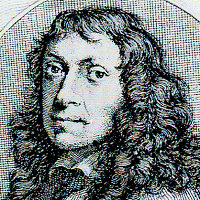 |
Willem Kalf, 1619–93. Dutch painter. Kalf was born in Rotterdam, then spent five years in Paris, then returned to Holland, eventually settling in Amsterdam. In the second half of the century, he became the leading painter of pronkstilleven (ostentatious Still Lifes) containg exotic and expensive objects beautifully rendered in glowing color. |
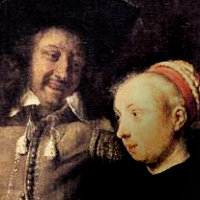 |
Gabriel Metsu, 1629–67. Dutch painter. He trained and worked originally in his native Leiden, then moved to Amsterdam in 1657. He is best known for his genre scenes, which give us an excellent picture of Dutch middle-class life. His style is not unlike that of Vermeer, though he is more anecdotal. [The image is a self-portrait with his wife.] |
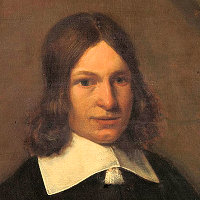 |
Pieter de Hooch, 1629–84. Dutch painter. His best paintings date from his years in Delft (1655–61), and show scenes of urban life in the sunlit rooms and inner courtyards of Dutch houses, in a manner not too dissimilar from Vermeer. Later in Amsterdam, his quality took second place to quantity. He died in a madhouse. |
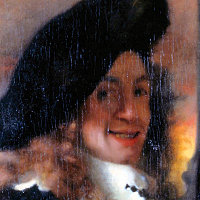 |
Johannes Vermeer, 1632–75. Dutch painter. Now considered second only to Rembrandt among the geniuses of the Golden Age, Vermeer did not have much success in his lifetime. Although most of his relatively small body of work could be described as genre subjects (for example, women engaged in household tasks), their sense of greater significance—a simple act suspended in eternity—is not easily explained, though much has to do with the solidity of his forms, his sense of light, and a paint surface that one contemporary described as "crushed pearls melted together." |
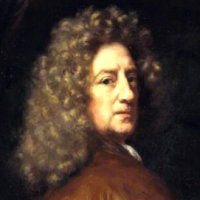 |
Nicolaes Maes, 1634–93. Dutch painter. Born in Dordrecht and a pupil of Rembrandt, he is best known for genre scenes of a rather sentimental quality, but painted with the glowing technique of his master. |
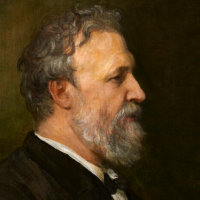 |
Robert Browning, 1812–89. English poet. Although best known today for his lyrical and shorter narrative verse, Browning established a reputation as a leading Victorian poet also through longer works such as the play Pippa Passes (1841) and the novel-length The Ring and the Book (1869). |
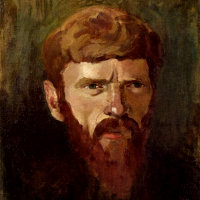 |
D. H. Lawrence, 1885–1930. English novelist and poet. DH (David Herbert) Lawrence was described by EM Forster (who should know) as "the greatest imaginative novelist of our generation." He was little understood in his time, however, with his major novels Sons and Lovers (1913), Women in Love (1920), and Lady Chatterley's Lover (1928) all subject to censorship for their frank dialogue and explicit treatment of sex. As a result, he spent much of his career in virtual exile. He was also an eloquently lyrical poet and accomplished painter. |
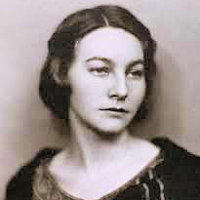 |
Genevieve Taggard, 1894–1948. American poet. Taggard grew up in Hawaii, where her parents were missionaries. She was educated at Berkeley, then went on to teach at Bennington and Sarah Lawrence. A Guggenheim award enabled her to travel to Spain shortly before the Civil War, an experience that informed the social and political content much of her later poetry. |
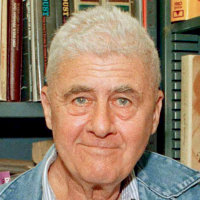 |
Howard Nemerov, 1920–91. American poet. Nemerov's parents were Russian immigrants and owners of a Fifth Avenue department store. He was educated at Harvard, and went on to teach at Bennington, Brandeis, and Washington University in St. Louis. He has won the National Book Award and the Pulitzer Prize and has twice served as US Poet Laureate. His style tends to be both formalistic and witty. |
 |
Jane Kenyon, 1947–95. American poet. Kenyon studied at the University of Michigan in her home town of Ann Arbor. In 1972, she married her teacher, poet Donald Hall, and moved with him to New Hampshire. At the time of her untimely death from leukemia, she was Poet Laureate of New Hampshire. |
 |
Julia Spicher Kasdorf, 1962– . American poet. Kasdorf was brought up in a Mennonite family, and much of her poetry explores the contrasts between that enclosed world and her experience of more open settings. Her three published collections have all been honored with prizes. |
ART: For the paintings discussed (or intended to be discussed) in class see below. Scroll to the end or click these links to reach the sections on POETRY and BIOS.
COMPARISON 1



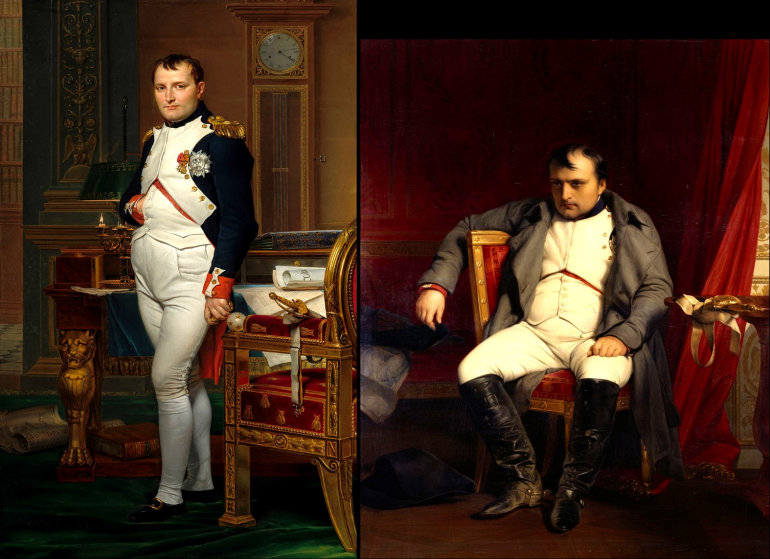
Some questions: How does each painter handle the physical architecture? Do you accept it as a faithful representation of a Dutch House? Of the life lived in that house? How has each artist treated the figures? Do any of the pictures suggest a narrative?
Some facts: The works of Jan Vermeer (1632–75) are difficult to date; this one is probably fairly early, around 1658. Most of the works in today's class, however, come from the 1660s; I shall not aim for further accuracy unless they are earlier or later. Pieter de Hooch (1629–84) was born in Rotterdam but, like Vermeer, he is most associated with Delft. The three people at the table in the third picture may be indulging in a game called "Pass Glass," in which each successive drinker must drink down to the next line on the tall glass or pay a forfeit.
COMPARISON 2




Some questions: What can you deduce about the woman with the wine glass in each of the three pictures? And her relationship of the man closest to her? In the first and third pictures, what is the function of the other characters? Is there are suggestion of music in any of the three, and if so why? What is the function of the picture above the fireplace in the first picture and the stained glass in the second? If I told you that X-rays reveal that there was originally a man flirting with the maid in the first picture, would that alter your understanding of it?
Some facts: Both the Vermeer pictures are relatively early works in which he seems to be trying his hand at subjects taken from rather older painters. The model for The Wine Glass is probably De Hooch, though not necessarily this particular picture. The Procuress theme seems taken from a painting by Dirck van Baburen (1597–1624) owned by Vermeer's mother-in-law. In his mature paintings, Vermeer generally handled such narrative elements with greater ambiguity.
COMPARISON 3




Some questions: Which picture makes us most curious about what the woman is reading, and which the least? If there is more than one character in the picture, what are the others doing? What can we glean from the objects in each picture? What is the social class in each? Is there any significance in the dogs?
Some facts: The earliest of the three (but by only a few years) is likely to be the picture with the dark background, by Gerard Terborch (or ter Borch, 1617–81); it is also the most socially elevated setting and contains passages of paint obviously intended to show the painter's skill. On the other hand, the relationship between the older and younger woman remains an enigma; the boy is probably a servant. The middle picture, by Gabriël Metsu (1629–67), offers more clues, suggesting perhaps that the woman's husband is away at sea; the spaniel symbolizes loyalty. Metsu has addressed the letter that the maid is holding with his own signature. By contrast, Vermeer keeps such references to a mimimun; the map on the wall might indicate that the writer of the letter is away traveling, but such maps are common wall decorations. There is no reason to suppose that the woman is pregnant (though she might be); her loose clothes are the fashion of the time.
COMPARISON 4



Some questions: In what room of the house is each picture set? What is the social class of the people represented? Can you place each on a timeline of before, during, or after a meal? Is there an implied moral in the two pictures with a sleeping girl, and is it the same in each case? How might you look at the other two pictures in moral terms? X-rays reveal that Vermeer originally showed a man standing in the doorway behind the sleeping girl, and a jug on its side beside the knife on the table; how would these have changed the picture, and why do you think he removed them?
Some facts: The moral component of the two works by Nicolaes Maes (1634–93)is obvious—the one an overt caution against laziness, the other a homily on humble piety—but Vermeer plays his cards closer to his chest. Had he retained the figure of the departing man (not to mention the crude but common symbolism of a knife placed beside an open jar), the Sleeping Girl would clearly represent a postcoital situation; as it is, the narrative is ambiguous, though she has clearly had company, and she may have had too much to drink. Although compared here to a painting of a servant, Vermeer's girl seems of a higher class. There are some erotic implications in The Milkmaid as well (see the article on Wikipedia), but they are overshadowed by the almost sacred appreciation of simple nurture—literally the bread of life.
COMPARISON 5




Some questions: Which picture is the most natural, in terms of a grouping of objects that just happen to be on the table at that moment? Which is the most obviously arranged? But in fact all three are carefully arranged: how, and why? What is the social class represented in each picture? Do any of them carry a moral message? Why do you think people bought them?
Some facts: Like the breads in the Vermeer picture, earlier Dutch still lifes often supported the notion of domestic virtue: a well-ordered life based on simple components, such as the meal of beer and herring in the one by Pieter Claesz (1597–1660). The arrangement with the skull is known as a Vanitas, or reminder that the material things in this world must come to dust. The picture by Willem Kalf (1619–93), though, is the opposite, belonging to the later genre of pronkstilleven or ostentatious still lifes. Paradoxically, they may also serve as reminders of all those material things that will not last, but it is more likely that they were bought by purchasers whose budgets could stretch to a touch of luxury in a painting, but not sustain it as a lifestyle.
COMPARISON 6




Some questions: I originally kept the titles concealed to ask which if any of these is likely to be a portrait of a real individual whose name is part of the title? Who would have paid for each of them, and why? Are they all wearing their own clothes?
Some facts: A popular genre in golden-age Dutch art was the tronie, or head-and-shoulders portrayal of a model dressed in costume and/or showing a strong dramatic expression; these sold well and, although modeled by real people, the sitters' names were not recorded. Vermeer's painting belongs to this category, as does his Girl with a Pearl Earring. The two paintings by Rembrandt (1606–69) are portraits of his two life partners. The one of his wife Saskia van Uylenburgh was done at the time of their engagement. She was a burgomaster's daughter, and the picture is virtually indistinguishable from a commissioned portrait. A couple of years after Saskia died at the age of 28, Rembrant began a lifelong relationship with his housekeeper Hendrickje Stoffels; this portrait of her is much more informal and was probably never sold.

Vermeer: Allegory of Painting (1667 Vienna)
Some questions: Finally, a single picture to discuss if there is time. It is more elaborate than any of the other Vermeers that we have seen, though it contains many of the same elements. What are these elements? Compared to his other pictures, what is new? Can you suggest a possible title?
Some facts: The subject has been interpreted as an Allegory of Painting, with the woman representing either Fame or one of the Muses. It is thought that Vermeer might have painted this as a sample of his skill, to have something around he could show to potential patrons. It is known that he was very proud of it and, though he could ill afford such gestures, refused to sell it during his lifetime, and that his wife attempted to block its sale after his death.
POETRY: Readings of all the poems except the Nemerov and the Taggard are on YouTube:
Browning: Love in a Life, read by Simon Clark
Lawrence: Piano, read by Tony Britton
Kasdorf: What I Learned from my Mother, read by the author
Kenyon: Otherwise, read by the author
Click here for the texts of all six poems and the script.
PEOPLE: Here are brief bios of the painters and novelists we considered in the class.
 |
Pieter Claesz, 1597–1660. Dutch painter. Though born near Antwerp, he moved to Haarlem in is early twenties, and there became a leading painter of Still Lifes, using subtle modulation of a limited palette, and often with some allegorical or moral overtone. He was also a musician. [The illustration is a distant reflection of the painter in one of his works.] |
 |
Rembrandt Harmenzoon van Rijn, 1606–69. Dutch painter and printmaker. The greatest artist of the Dutch Golden Age, he nonetheless retained his own style which set him apart from his contemporaries. There is a strong baroque influence earlier in his career, but his later work developed a quality of deep introspection in which the subject seems to glow within rich layers of paint. |
 |
Willem Kalf, 1619–93. Dutch painter. Kalf was born in Rotterdam, then spent five years in Paris, then returned to Holland, eventually settling in Amsterdam. In the second half of the century, he became the leading painter of pronkstilleven (ostentatious Still Lifes) containg exotic and expensive objects beautifully rendered in glowing color. |
 |
Gabriel Metsu, 1629–67. Dutch painter. He trained and worked originally in his native Leiden, then moved to Amsterdam in 1657. He is best known for his genre scenes, which give us an excellent picture of Dutch middle-class life. His style is not unlike that of Vermeer, though he is more anecdotal. [The image is a self-portrait with his wife.] |
 |
Pieter de Hooch, 1629–84. Dutch painter. His best paintings date from his years in Delft (1655–61), and show scenes of urban life in the sunlit rooms and inner courtyards of Dutch houses, in a manner not too dissimilar from Vermeer. Later in Amsterdam, his quality took second place to quantity. He died in a madhouse. |
 |
Johannes Vermeer, 1632–75. Dutch painter. Now considered second only to Rembrandt among the geniuses of the Golden Age, Vermeer did not have much success in his lifetime. Although most of his relatively small body of work could be described as genre subjects (for example, women engaged in household tasks), their sense of greater significance—a simple act suspended in eternity—is not easily explained, though much has to do with the solidity of his forms, his sense of light, and a paint surface that one contemporary described as "crushed pearls melted together." |
 |
Nicolaes Maes, 1634–93. Dutch painter. Born in Dordrecht and a pupil of Rembrandt, he is best known for genre scenes of a rather sentimental quality, but painted with the glowing technique of his master. |
 |
Robert Browning, 1812–89. English poet. Although best known today for his lyrical and shorter narrative verse, Browning established a reputation as a leading Victorian poet also through longer works such as the play Pippa Passes (1841) and the novel-length The Ring and the Book (1869). |
 |
D. H. Lawrence, 1885–1930. English novelist and poet. DH (David Herbert) Lawrence was described by EM Forster (who should know) as "the greatest imaginative novelist of our generation." He was little understood in his time, however, with his major novels Sons and Lovers (1913), Women in Love (1920), and Lady Chatterley's Lover (1928) all subject to censorship for their frank dialogue and explicit treatment of sex. As a result, he spent much of his career in virtual exile. He was also an eloquently lyrical poet and accomplished painter. |
 |
Genevieve Taggard, 1894–1948. American poet. Taggard grew up in Hawaii, where her parents were missionaries. She was educated at Berkeley, then went on to teach at Bennington and Sarah Lawrence. A Guggenheim award enabled her to travel to Spain shortly before the Civil War, an experience that informed the social and political content much of her later poetry. |
 |
Howard Nemerov, 1920–91. American poet. Nemerov's parents were Russian immigrants and owners of a Fifth Avenue department store. He was educated at Harvard, and went on to teach at Bennington, Brandeis, and Washington University in St. Louis. He has won the National Book Award and the Pulitzer Prize and has twice served as US Poet Laureate. His style tends to be both formalistic and witty. |
 |
Jane Kenyon, 1947–95. American poet. Kenyon studied at the University of Michigan in her home town of Ann Arbor. In 1972, she married her teacher, poet Donald Hall, and moved with him to New Hampshire. At the time of her untimely death from leukemia, she was Poet Laureate of New Hampshire. |
 |
Julia Spicher Kasdorf, 1962– . American poet. Kasdorf was brought up in a Mennonite family, and much of her poetry explores the contrasts between that enclosed world and her experience of more open settings. Her three published collections have all been honored with prizes. |
